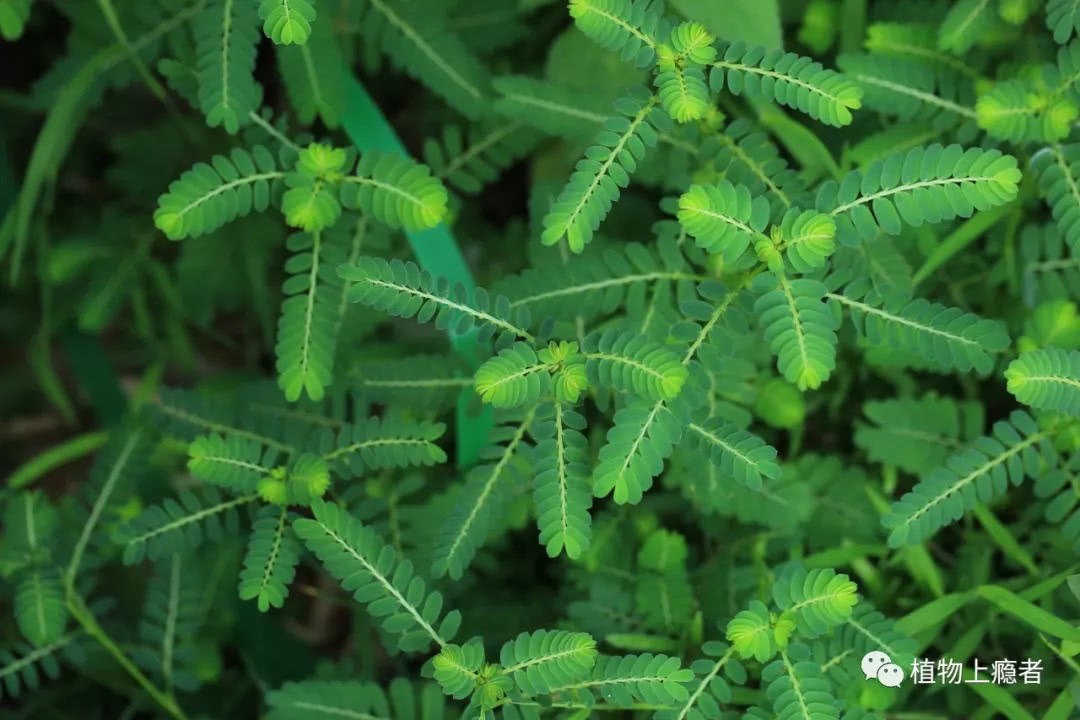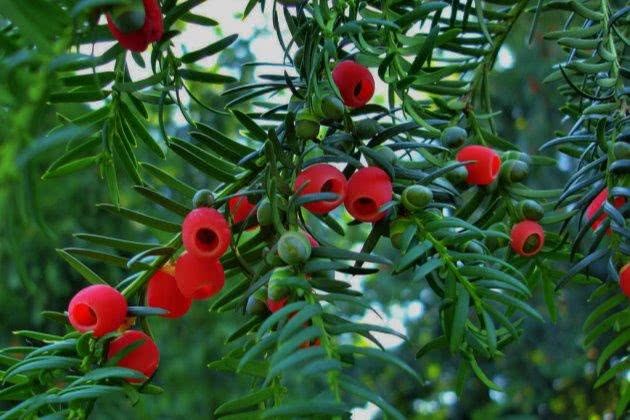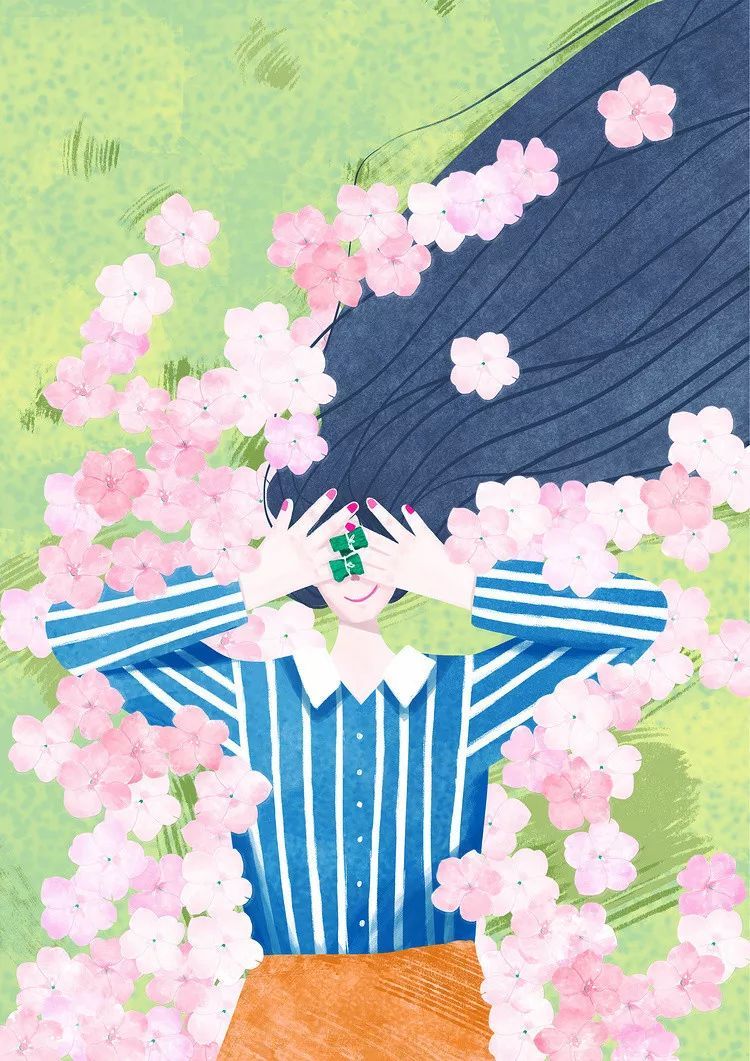This little pee liar. Who told me to love you?

Phyllanthus involucrata
Phyllanthus urinaria
Phyllanthus (Phyllanthus)
Annual herbs
After writing this article this morning, I was preparing for typesetting when the article suddenly disappeared, probably deleted by mistake. I tried two data recovery software, but I couldn't find it. Forget it. I'd better rewrite it honestly.
Ye Xiazhu, whose name is beautiful and imaginative, is actually a common weed in the garden.
The high temperature even sunny, people and trees are wilted by the sun, but it seems to damage the vitality of the leaves. Throughout the summer, the whole garden is dominated by Phyllanthus chinensis. They are green and green, laying a cool carpet for the earth. I think it is appropriate to describe the temperament of Xiazhu, which means "the appearance of luxuriant vegetation and drooping branches and leaves".
Xiazhu Ye and I have known each other for many years. When I notice it every year, it is the height of summer, when its little green beads hang under the leaves. This is the origin of Ye Xiazhu. It is said that when mature, green beads will turn into red beads, I have not seen it with my own eyes, and I am looking forward to it.
Green and red beads are all capsules of Phyllanthus angustifolia. This bead is lovely and looks like a round pearl, but it is a typical "beauty of distance"-when enlarged enough, you will see that the surface is actually covered with small thorns.
There are pearls under the leaves
The surface of the beads is actually uneven.
The edges of the leaves are also hairy.
Where there is fruit, there must be flowers. However, the flower of Ye Xiazhu is too small to look for it, and the result must be missed. That's what happened last year, and this year I learned my lesson and finally caught them.
The flowers of Phyllanthus are male and female, unisexual but monoecious. The male flower grows at the top of the branchlet and the female flower grows at the lower end of the branchlet. Male flowers are usually several in clusters, but usually only one develops. It looks like a solitary leaf axil, with six yellowish green translucent sepals, a disk of the same color, and three stamens. Female flowers are usually solitary, with 6 yellowish green sepals and disk, slightly smaller than male flowers. Orange anthers can easily distinguish male flowers from female flowers.
You may have noticed that I did not mention the petals of Phyllanthus. Its flowers have no petals.
Male flowers with orange anthers
Female flower
The upper part of male peanut branchlets and the lower part of female peanut
The leaves of Phyllanthus angustifolia are also very deceptive and look like little green feathers. I took it for granted that it was a pinnate compound leaf, but I was wrong. It is clearly written in the Flora of China that the leaves are solitary and pinnately arranged due to the twisting of the petiole.
But I am curious: is the longitudinal axis between the two rows of leaflets a branchlet or the petiole of a compound leaf? which criterion is it? I have been asked the same question before, especially when identifying two pinnately compound leaves.
The answer lies here: whether it can sprout and blossom. What can blossom on it is the branchlet; what cannot blossom is the leaf axis. I recalled that the leaves were a pinnately compound rose, Robinia pseudoacacia or all kinds of cassia. Indeed, the flowers never bloomed on the leaf axis.
Simple leaves alternate, disguised as pinnately compound leaves
This is not over. Xiazhu Ye continues to "deceive" me. When observing the specimen, I thought its delicate leaflet was entire and glabrous, which once made me suspect that I had chosen the wrong species, because there was a characteristic of Phyllanthus angustifolia, that is, "there are 1-3 rows of hispidulous hairs on the lower edge of the leaf." I didn't see this feature clearly until I zoomed in with a macro lens (see the close-up of the prickly fruit above).
The significance of such details as "hairy and hairless" is that Phyllanthus is a large family, with a total of nearly 800 species, and there are also 30 + species in China. There are many kinds that look very similar. For example, the following kind of honey citrus grass (Phyllanthus ussuriensis) did not pay attention to when singing plum, but it was the sharp-eyed Lele children who found the difference.
Honey citrus grass, taken by Zhang Yongmei in Xiamen
This specimen, pulled back by my father, grew in a large vat downstairs of my house, with a length of 30 centimeters. Soon, its two rows of leaflets closed and could not be broken apart, just like a mimosa. This is often mistaken for legumes. The aliases of closing grass and closing door grass all refer to this characteristic of Phyllanthus angustifolia. A more interesting record comes from the Guangzhou Flora: "A child in Meixian County pulled up this plant at the edge of the field during the summer moon, saying'Hu shyness', and its leaves soon closed, so it was commonly known as Hu shyness."
The name Ye Xiazhu first came from the textual Research on the name of plants written by Wu Qiyi in the Qing Dynasty (1880): "Ye Xiazhu is common in Jiangxi and Hunan. Four or five inches high, just like the budding of trees at night, the leaves also open during the day and close at night, and the leaves grow like millet along the stem, giving birth to yellow and ripe purple. Slang medicine is cool in nature and can get rid of miasma. "
The generic name Phyllanthus of Phyllanthus angustifolia is a combination of the Greek root phyllon leaves and anthos flowers, which refers to peanuts on the back of petiolate branches. The word urinaria means "urine". When I first knew it, my father told me that Phyllanthus mandshurica can "tonify the kidney". Traditional Chinese medicine says "kidney division two defecate". In Chinese herbal medicine, Phyllanthus belongs to the category of diuresis, mainly for urinary tract infection, urinary tract calculi and so on.
I have always had a selfish preference for Xiazhu Ye, and her "urinating" temper is actually very agreeable to me: what you see is often not true. It takes extra time, patience and attention to see the truth. In this day and age, attention and time are the scarcest resources, and of course true love can do this.
Xiazhu Ye teased me anytime, anywhere. For example, its young leaves look completely different. The flowerpot on the balcony always grows a lot, which used to confuse me. Of course, by now, I recognize you even if you have melted, hem.
Young leaf
He Zhizhang Shiyun, when he was a teenager, he left his hometown and didn't come home until he was old. The local accent did not change his temples. The children met but did not know each other, and they smiled and asked where the guest came from. What the villagers remember is his face when he was young. In the plant world, I have repeatedly experienced the opposite experience: I know what plants and plants look like when they are adults, but I often don't recognize them when they are young.
Like the compound-feathered Luan tree that is in full bloom. This is one of my favorite trees. I wrote an article about it the year before last. "all the beauty in this world is not as beautiful as the first time I met you." I thought I was quite familiar with it. However, the saplings everywhere in this kind of garden, at first I still admitted that I was wrong.
Koelreuteria paniculata in its infancy
Opposite the office, Fuyu Luan flower blossoms just right.
Distribution:
Produced in southwest, South China, Central China, East China, Shanxi, Shaanxi, Hebei and other provinces, usually born in the wilderness, dry fields, mountain roadsides or forest margins below 500 meters above sea level. It is also distributed in India, Sri Lanka, Indochina, Japan, Malaysia, Indonesia and South America.
The article and plant pictures (except for the origin) are all original by the author.
Your retweet compliment is the greatest support for me.
Plant addict
WeChat account: plantfiend
Discover the unique beauty of each plant
- Prev

The yew bonsai is green all the year round.
Taxus is a good potted green plant. Taxus culture can help people beautify the environment, decorate the home environment and purify the air. So we often breed it in a brightly lit place or balcony at home.
- Next

We spend 500 yuan on exquisite manicures and begin to miss the time when we dyed our nails with it.
Peony's love for flowers and plants began at a very young age. When I miss my childhood, I remember many stories related to plants. For example, everyone is familiar with dogtail grass, which can be woven into rings and bunnies.
Related
- Wuhan Hospital Iron Tree Blooming Result Was Instantly Frightened by the Gardener Master
- Which variety of camellia is the most fragrant and best? Which one do you like best?
- What is the small blue coat, the breeding methods and matters needing attention of the succulent plant
- Dormancy time and maintenance management of succulent plants during dormancy
- Minas succulent how to raise, Minas succulent plant pictures
- What are the varieties of winter succulent plants
- How to raise succulent plants in twelve rolls? let's take a look at some experience of breeding twelve rolls.
- Attention should be paid to water control for succulent plants during dormant period (winter and summer)
- Watering experience of twelve rolls of succulent plants
- Techniques for fertilizing succulent plants. An article will let you know how to fertilize succulent plants.

